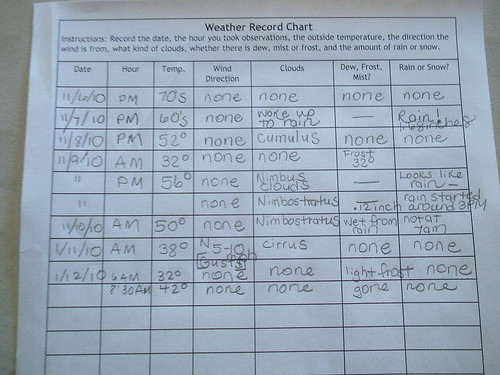Our typical November weather is very unpredictable. We can have warm sunny days filled with outdoor activities or we can have cold, wet day where you stand at the window and wonder when it will end. Both were experienced this week as part of our official seasonal weather observations.
Using the chart provided in the ebook, we all worked together to keep track of morning and afternoon temperatures and other factors like wind, rain, clouds, etc. Our outdoor thermometer is broken so we had to take a portable one outdoors to make our measurements each time.

Comparing our morning and afternoon temperatures was interesting because of the large span of numbers on a few of the days. We had one day with a 24 degree change in temperature within a few hours and from day to day it was widely varied as well. I am the official record keeper for this challenge since they like the observation part but not the actual writing it down in a journal part.

Unofficial time spent outdoors found us raking leaves for the compost bin, noticing how beautifully the leaves fell in a pile around the base of this tree.

Observing clouds was fun this week since we had a variety to enjoy.

The changing color in most all the deciduous plants in the yard like this grape vine is happening before our very eyes.

More raking after the rain came through...these are the walnut tree leaves which have a particular odor that is imprinted in your brain once you smell it.

We also took a drive over the Sierra on Thursday and saw the mountains with a fresh blanket of snow that will more than likely stay there until late next spring.

We stopped to take in the snow at the summit and it was cold! This is about an hour's drive from our house and very near to where the Donner Party was stranded if you have read about them in your history study. I highly recommend Patty Reed's Doll if you are interested in reading a children's version of their survival during the winter of 1846.
Our weather study will be on-going as we keep adding to our weather chart and it will give us some great data to use to compare to our winter observations.
Thanks for coming along with our study.
Barb-Harmony Art Mom
